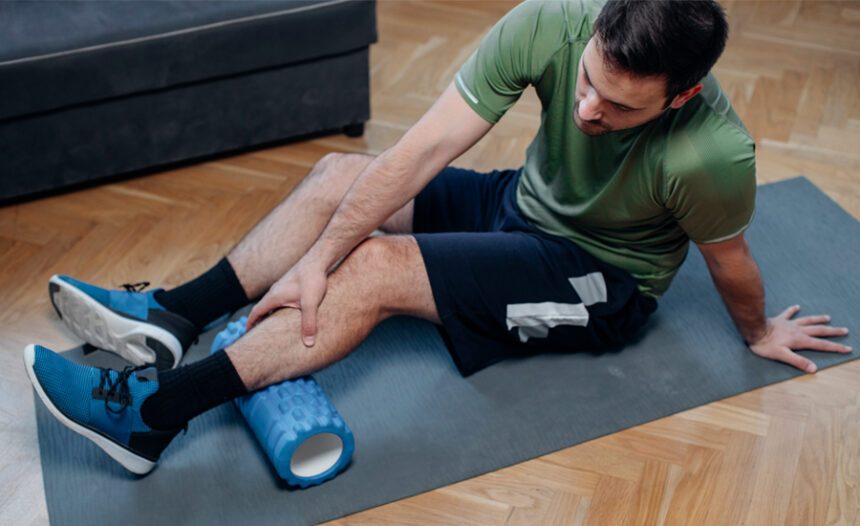Nothing throws a wrench in your workout quite like a cramp. But listen to your body: While it can be painful, the sharp sensation of your muscle suddenly tightening is a warning sign that you’re about to overload it.
“Your brain sends a signal through your nerves to tell you that your muscle isn’t ready for what you want it to do,” says UNC Health sports medicine specialist Nailah Adams, MD.
Cramps can affect any muscle, but they commonly happen in the calves, hamstrings and hands. Dr. Adams shares what causes cramps and what to do when they happen to you.
What Causes Cramps During Exercise?
You could experience a cramp while exercising for several reasons:
- Premature fatigue: This is when the muscle is overworked and becomes too tired to perform the exercise. “The muscle is either being asked to shorten or contract too soon or is being overloaded more than it’s ready,” Dr. Adams says.
- Inadequate preparation: You’re asking your muscles to do too much, too fast—for example, going from not running at all to running a 5K race without training. You can also cramp if you haven’t warmed up your muscles before working out.
- Dehydration: Not drinking enough water before and during exercise can cause the muscles to tire easily.
- Lack of electrolytes: Electrolytes are minerals in your blood and other body fluids that help your body function. These include sodium, potassium and chloride. You lose electrolytes when you sweat, which can lead to muscle cramping.
- Blood disorders: People with blood disorders such as sickle cell anemia are more likely to cramp, as their blood may have more trouble delivering oxygen to a demanding muscle.
“If you repeatedly cramp, talk to your doctor,” Dr. Adams says. “Especially if you’re losing a lot of salt (check for dusty white sweat on your clothes) or urinating often, it’s best to get a checkup.”
What to Do if You Get a Cramp While Exercising
If you experience a cramp while exercising, Dr. Adams says to do the following:
1. Stop the exercise.
Don’t try to push through it. You need to allow the muscle to recover.
2. Massage and stretch the muscle.
Knead or stretch the muscle to help it relax. “Avoid quickly grabbing the muscle and letting it go. You need to keep gentle pressure on it until the tightness releases,” Dr. Adams says.
It’s best if someone else can stretch you, just like you see professional athletes doing on the sidelines. That way, you can relax while someone else works the muscle, Dr. Adams says.
But don’t worry if you’re by yourself. Just apply slow pressure and gently stretch the muscle as best you can. Use walls, chairs, footstools or other items to support you.
3. Try the exercise again, slowly.
If you’re able to work out the cramp, you can go back and try the exercise again. Warm up and hydrate first, with more stretching or using a muscle roller, and ease into it.
“Cramping is temporary,” Dr. Adams says. “It doesn’t mean you have to stop exercising completely.”
If the cramp returns, switch to another exercise or muscle group.
- If cramping is persistent, get a checkup.
If the cramping becomes a regular occurrence, it’s best to get a checkup from your primary care doctor or a sports medicine doctor to get to the root of the issue.
5 Ways to Prevent Cramps While Exercising
While cramps are unpredictable, there are things you can do to lessen the likelihood that you will get one.
1. Don’t overdo your movements.
Your muscles need to be conditioned and ready to do the exercise you want them to do. Prepare with appropriate training, whether that is strength or endurance work, Dr. Adams says.
2. Practice dynamic stretching.
Dynamic, or movement-based, stretching is usually more effective than static stretching before physical activity. For example, a toy soldierstretch, where you lift up your legs toward your hands extended in front of you, is appropriate to do before a run. The traditional standing hamstring stretch, where you reach down to touch your toes and hold the pose, may be better after your run.
3. Use a foam roller.
Foam rolling—using a foam tube to apply pressure to muscles you are about to use—or another muscle roller can help release muscle tension. It is a good preventive step to relax the muscles prior to exercise, Dr. Adams says.
4. Eat healthy, hydrate and keep your electrolyte levels up.
Drink plenty of water before you exercise to prevent dehydration. Or, as Dr. Adams puts it: “Wet muscles are happy muscles.”
Eat a healthy, balanced diet with lots of fruits and vegetables to keep your electrolytes in check. You can also use low-sugar versions of sports drinks such as Gatorade or Propel to help replenish salt and minerals.
5. Don’t feel the need to drink pickle juice—unless you really like it.
You may have heard that you can drink pickle juice or eat mustard or bananas to prevent cramps. Dr. Adams says those remedies are not well-studied, and what they really point to is the body’s need for electrolytes.
“Some of the treatments that have been used for decades, like pickle juice, are thought to help because of their high salt and electrolyte content,” Dr. Adams says.
She says it’s better to focus on eating healthy and conditioning your muscles, and to remember the importance of rest and recovery.
“We want you to be active and stay healthy and fit in whatever activity you love,” Dr. Adams says. “Listen to your body and know your limits, and if you want to push yourself beyond those limits, please do so gradually.”
Injured playing sports or exercising? Talk to your doctor or find one near you.

